Information injection-pump assembly
BOSCH
9 400 612 323
9400612323
ZEXEL
108622-4011
1086224011
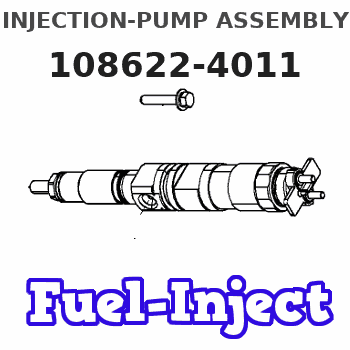
Rating:
Service parts 108622-4011 INJECTION-PUMP ASSEMBLY:
1.
_
5.
AUTOM. ADVANCE MECHANIS
9.
_
11.
Nozzle and Holder
12.
Open Pre:MPa(Kqf/cm2)
15.7{160}/21.6{220}
14.
NOZZLE
Include in #1:
108622-4011
as INJECTION-PUMP ASSEMBLY
Cross reference number
BOSCH
9 400 612 323
9400612323
ZEXEL
108622-4011
1086224011
Zexel num
Bosch num
Firm num
Name
108622-4011
9 400 612 323
DAEWOO
INJECTION-PUMP ASSEMBLY
DE12TIS K 14CJ INJECTION PUMP ASSY TICS HD-TI6M TICS
DE12TIS K 14CJ INJECTION PUMP ASSY TICS HD-TI6M TICS
Calibration Data:
Adjustment conditions
Test oil
1404 Test oil ISO4113 or {SAEJ967d}
1404 Test oil ISO4113 or {SAEJ967d}
Test oil temperature
degC
40
40
45
Nozzle and nozzle holder
105780-8250
Bosch type code
1 688 901 101
Nozzle
105780-0120
Bosch type code
1 688 901 990
Nozzle holder
105780-2190
Opening pressure
MPa
20.7
Opening pressure
kgf/cm2
211
Injection pipe
Outer diameter - inner diameter - length (mm) mm 8-3-600
Outer diameter - inner diameter - length (mm) mm 8-3-600
Overflow valve
134424-4120
Overflow valve opening pressure
kPa
255
221
289
Overflow valve opening pressure
kgf/cm2
2.6
2.25
2.95
Tester oil delivery pressure
kPa
255
255
255
Tester oil delivery pressure
kgf/cm2
2.6
2.6
2.6
PS/ACT control unit part no.
407980-2
24*
Digi switch no.
31
Direction of rotation (viewed from drive side)
Right R
Right R
Injection timing adjustment
Direction of rotation (viewed from drive side)
Right R
Right R
Injection order
1-5-3-6-
2-4
Pre-stroke
mm
6.4
6.37
6.43
Beginning of injection position
Governor side NO.1
Governor side NO.1
Difference between angles 1
Cal 1-5 deg. 60 59.75 60.25
Cal 1-5 deg. 60 59.75 60.25
Difference between angles 2
Cal 1-3 deg. 120 119.75 120.25
Cal 1-3 deg. 120 119.75 120.25
Difference between angles 3
Cal 1-6 deg. 180 179.75 180.25
Cal 1-6 deg. 180 179.75 180.25
Difference between angles 4
Cyl.1-2 deg. 240 239.75 240.25
Cyl.1-2 deg. 240 239.75 240.25
Difference between angles 5
Cal 1-4 deg. 300 299.75 300.25
Cal 1-4 deg. 300 299.75 300.25
Injection quantity adjustment
Adjusting point
-
Rack position
15.7
Pump speed
r/min
630
630
630
Average injection quantity
mm3/st.
166.5
163.5
169.5
Max. variation between cylinders
%
0
-2
2
Basic
*
Fixing the rack
*
PS407980-224*
V
2.45+-0.
01
PS407980-224*
mm
4+-0.05
Standard for adjustment of the maximum variation between cylinders
*
Injection quantity adjustment_02
Adjusting point
Z
Rack position
8.9+-0.5
Pump speed
r/min
445
445
445
Average injection quantity
mm3/st.
13.5
12
15
Max. variation between cylinders
%
0
-15
15
Fixing the rack
*
PS407980-224*
V
V1+0.05+
-0.01
PS407980-224*
mm
6.3+-0.0
3
Standard for adjustment of the maximum variation between cylinders
*
Remarks
Refer to items regarding the pre-stroke actuator
Refer to items regarding the pre-stroke actuator
Injection quantity adjustment_03
Adjusting point
A
Rack position
R1(15.7)
Pump speed
r/min
630
630
630
Average injection quantity
mm3/st.
166.5
164.5
168.5
Basic
*
Fixing the lever
*
Boost pressure
kPa
109
109
Boost pressure
mmHg
820
820
PS407980-224*
V
2.45+-0.
01
PS407980-224*
mm
4+-0.05
Injection quantity adjustment_04
Adjusting point
B
Rack position
(R1+0.9)
Pump speed
r/min
1050
1050
1050
Average injection quantity
mm3/st.
143.5
137.5
149.5
Fixing the lever
*
Boost pressure
kPa
109
109
Boost pressure
mmHg
820
820
PS407980-224*
V
2.45+-0.
01
PS407980-224*
mm
4+-0.05
Boost compensator adjustment
Pump speed
r/min
250
250
250
Rack position
R2-3.85
Boost pressure
kPa
10.7
9.4
12
Boost pressure
mmHg
80
70
90
Boost compensator adjustment_02
Pump speed
r/min
250
250
250
Rack position
R2(R1+0.
15)
Boost pressure
kPa
96
96
96
Boost pressure
mmHg
720
720
720
0000001601
Pre-stroke
mm
6.4
6.37
6.43
Remarks
When the timing sleeve is pushed up
When the timing sleeve is pushed up
_02
Connector angle
deg.
8.5
8
9
Remarks
When the eccentric pin is tightened
When the eccentric pin is tightened
_03
Supply voltage
V
24
23.5
24.5
Ambient temperature
degC
23
18
28
Pre-stroke
mm
4
3.95
4.05
Output voltage
V
2.45
2.44
2.46
Adjustment
*
_04
Supply voltage
V
24
23.5
24.5
Ambient temperature
degC
23
18
28
Pre-stroke
mm
6.4
6.37
6.43
Output voltage
V
1.2
1
1.4
Confirmation
*
Remarks
Output voltage V1
Output voltage V1
_05
Supply voltage
V
24
23.5
24.5
Ambient temperature
degC
23
18
28
Pre-stroke
mm
3.4
Output voltage
V
3
2.98
3
Confirmation
*
_06
Supply voltage
V
24
23.5
24.5
Ambient temperature
degC
23
18
28
Output voltage
V
3.05
3.05
Confirmation of operating range
*
Test data Ex:
Governor adjustment
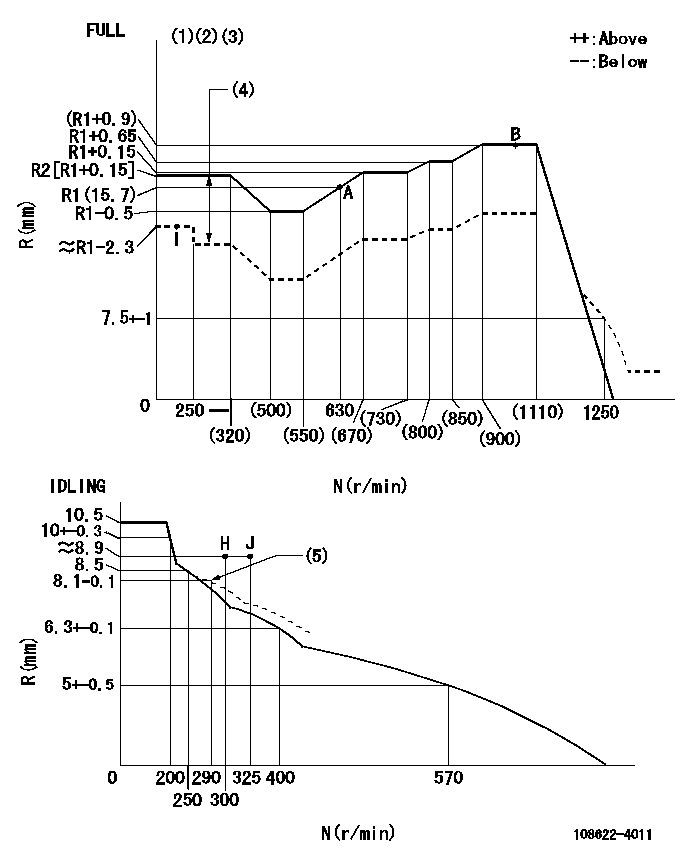
N:Pump speed
R:Rack position (mm)
(1)Torque cam stamping: T1
(2)Tolerance for racks not indicated: +-0.05mm.
(3)Microswitch adjustment unnecessary (deliver with adjusting bolt fully backed off).
(4)Boost compensator stroke: BCL
(5)Damper spring setting
----------
T1=AG98 BCL=3.85+-0.1mm
----------
----------
T1=AG98 BCL=3.85+-0.1mm
----------
Speed control lever angle
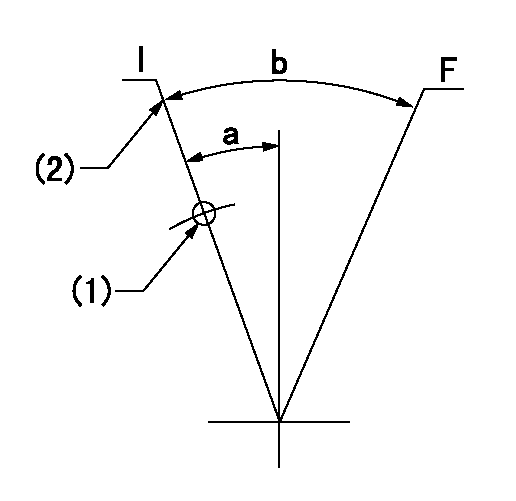
F:Full speed
I:Idle
(1)Use the hole at R = aa
(2)Stopper bolt setting
----------
aa=70.3mm
----------
a=10.5deg+-5deg b=38deg+-3deg
----------
aa=70.3mm
----------
a=10.5deg+-5deg b=38deg+-3deg
Stop lever angle
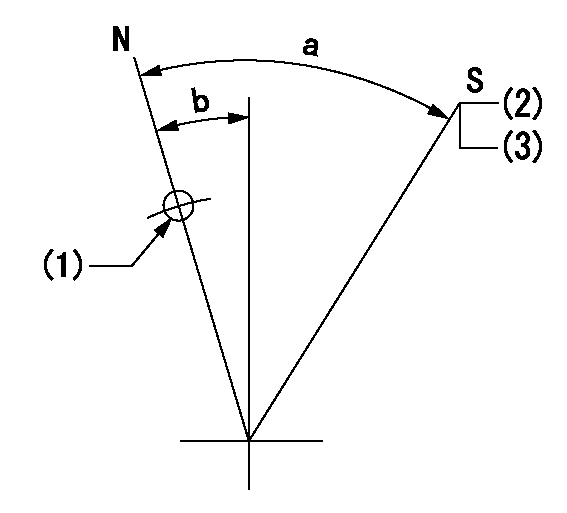
N:Pump normal
S:Stop the pump.
(1)Use the hole at R = aa
(2)Speed = bb, rack position = cc
(3)Set the stopper screw. (After setting, apply red paint.)
----------
aa=40mm bb=0r/min cc=1.5+-0.3mm
----------
a=44deg+-5deg b=20deg+-5deg
----------
aa=40mm bb=0r/min cc=1.5+-0.3mm
----------
a=44deg+-5deg b=20deg+-5deg
0000001301
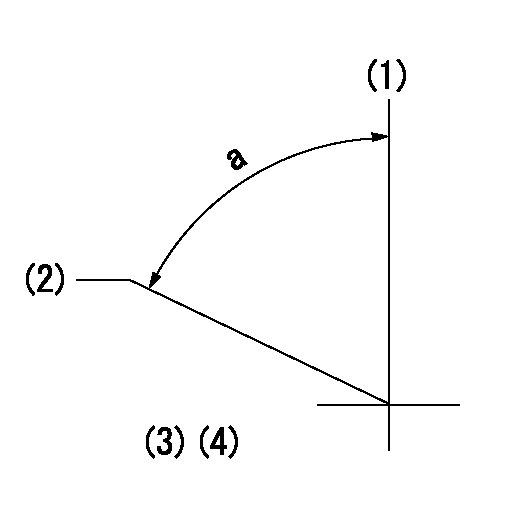
(1)Pump vertical direction
(2)Coupling's key groove position at No 1 cylinder's beginning of injection
(3)Pre-stroke: aa
(4)-
----------
aa=6.4+-0.03mm
----------
a=(70deg)
----------
aa=6.4+-0.03mm
----------
a=(70deg)
0000001901
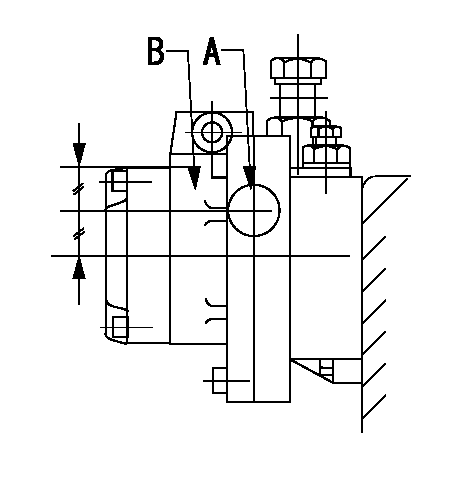
A:Sealing position
B:Pre-stroke actuator
1. When installing the pre-stroke actuator on the pump, first tighten the installation bolts loosely, then move the actuator fully counterclockwise (viewed from the drive side).
Temporary tightening torque: 1 - 1.5 N.m (0.1 - 0.15 kgf.m)
2. Move the actuator in the clockwise direction when viewed from the drive side, and adjust so that it becomes the adjustment point of the adjustment value. Then tighten it.
Tightening torque: 7^9 N.m (0.7^0.9 kgf.m)
3. After prestroke actuator installation adjustment, simultaneously stamp both the actuator side and housing side.
----------
----------
----------
----------
0000002201 RACK SENSOR
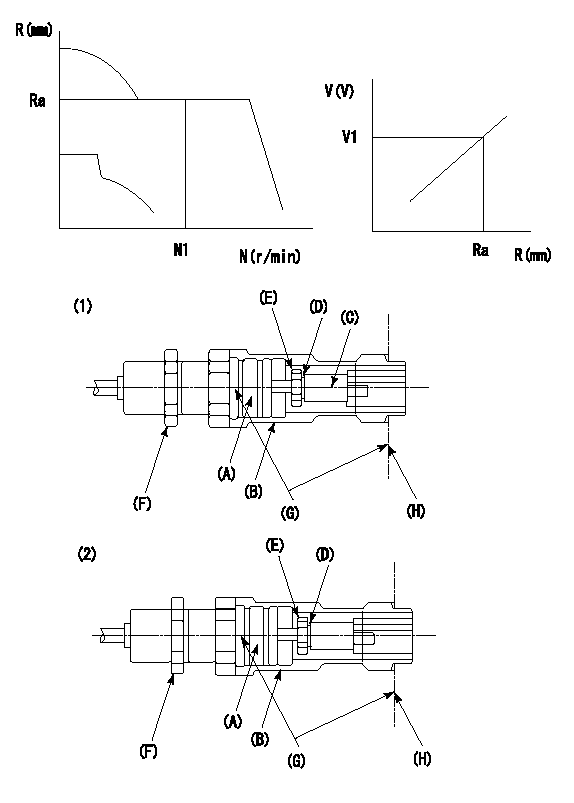
G:Red paint
H:Pump end face
P/N: part number of suitable shim
(1)Threaded type rack block
(2)Welded type rack block
Rack sensor adjustment
1. Threaded type rack sensor (-5*20, P type, no TICS rack limit).
(1)Screw in the bobbin (A) until it contacts the joint (B).
(2)Fix the pump lever.
(3)At speed N1 and rack position Ra, adjust the amount that the bobbin is screwed in so that the amp's output voltage is V1.
(4)Fix using the nut (F).
(5)Affix the caution plate to the upper part of the joint (B).
(6)Apply (G) at two places.
Connecting part between the joint (B) and the nut (F)
Connecting part between the end surface of the pump (H) and the joint (B)
2. Range for screw-in adjustment between the bobbin (A) and the joint (B) is 9 threads.
Screw in to the end from (the position where the bobbin (A) is rotated 9 turns).
Speed N1, rack position Ra, output voltage V1, rack sensor supply voltage 5+-0.01 (V)
----------
Ra=(R1(15.7)+0.9)mm N1=1050r/min V1=3+-0.01V
----------
----------
Ra=(R1(15.7)+0.9)mm N1=1050r/min V1=3+-0.01V
----------
Information:
(3) Check the unit seals installed in the impeller and water pump case for damage and wear. If defects are evident, or when water leaks during operation, replace the unit seals with new ones. Whenever the unit seal is removed, it must be replaced with a new one. (4) Using a gear puller or press, remove the ball bearings. Do not remove the ball bearing except for replacement. (5) When the impeller and flange are removed from the water pump shaft, it may result in insufficient interference. If the interference is below the specification even reassembly is two times or less they must be replaced with new ones.Reassembly
5.3 Thermostat
Removal and installation
Do not remove the thermostat case and front hanger unless they cause water leak or other defects.Inspection
Agitate water in the container with the stirrer to obtain uniform temperature. For the inspection, use the following procedures. (1) Slowly heat water to the thermostat valve opening temperature. Keep this condition for about five minutes and make sure that the valve is open.(2) Raise the water temperature up to 90°C. Keep the condition for five minutes and measure the lift of pellet.(3) Lower temperature down to 65°C or below and ensure that the valve is fully closed. If the thermostat is found defective in any of the above items, replace it with a new one. Support the thermostat so that the heat source will not directly heat the thermostat.5.4 Radiator
Inspection (1) Using a copper wire or similar device, remove dirt, mud, and bugs from the front of radiator core with care to prevent damage to tubings. (2) Connect a hose to one of the radiator ports, cap the other port, and immerse the radiator into water. Using a radiator cap tester, force the compressed air under the specified inspection pressure from the hose end to check for leaks.If there is a leak, resolder the point of leakage or replace the radiator.(3) Inspection of Radiator Cap Check the spring tension and sealing condition of the pressure valve and vent valve. If defective, replace. Check the pressure valve opening pressure, using a radiator cap tester.5.5 Inspection and Adjustment of V-belt Tension
Adjust the belt tension to obtain the specified belt deflection when the center of each belt is pressed with a force of approximately 98 N (10 kgf). 1. A slack belt can be a cause of overheating and undercharge.2. An excessively tight belt may result in damaged bearings and belts.3. When paired belts are to be replaced, be sure to replace both.5.6 Cleaning of Cooling System
If the radiator is used for a long time, rust, scale, mud, etc. are deposited inside, resulting in overheat. Clean the cooling system with city water by using the following procedures.The city water to be used should have the following properties.Required properties of city water 1. Use a cleaning solution if the radiator is seriously obstructed or coolant is seriously contaminated.2. When the cooling system is cleaned or washed with water, make sure that the coolant temperature is
5.3 Thermostat
Removal and installation
Do not remove the thermostat case and front hanger unless they cause water leak or other defects.Inspection
Agitate water in the container with the stirrer to obtain uniform temperature. For the inspection, use the following procedures. (1) Slowly heat water to the thermostat valve opening temperature. Keep this condition for about five minutes and make sure that the valve is open.(2) Raise the water temperature up to 90°C. Keep the condition for five minutes and measure the lift of pellet.(3) Lower temperature down to 65°C or below and ensure that the valve is fully closed. If the thermostat is found defective in any of the above items, replace it with a new one. Support the thermostat so that the heat source will not directly heat the thermostat.5.4 Radiator
Inspection (1) Using a copper wire or similar device, remove dirt, mud, and bugs from the front of radiator core with care to prevent damage to tubings. (2) Connect a hose to one of the radiator ports, cap the other port, and immerse the radiator into water. Using a radiator cap tester, force the compressed air under the specified inspection pressure from the hose end to check for leaks.If there is a leak, resolder the point of leakage or replace the radiator.(3) Inspection of Radiator Cap Check the spring tension and sealing condition of the pressure valve and vent valve. If defective, replace. Check the pressure valve opening pressure, using a radiator cap tester.5.5 Inspection and Adjustment of V-belt Tension
Adjust the belt tension to obtain the specified belt deflection when the center of each belt is pressed with a force of approximately 98 N (10 kgf). 1. A slack belt can be a cause of overheating and undercharge.2. An excessively tight belt may result in damaged bearings and belts.3. When paired belts are to be replaced, be sure to replace both.5.6 Cleaning of Cooling System
If the radiator is used for a long time, rust, scale, mud, etc. are deposited inside, resulting in overheat. Clean the cooling system with city water by using the following procedures.The city water to be used should have the following properties.Required properties of city water 1. Use a cleaning solution if the radiator is seriously obstructed or coolant is seriously contaminated.2. When the cooling system is cleaned or washed with water, make sure that the coolant temperature is
Have questions with 108622-4011?
Group cross 108622-4011 ZEXEL
Daewoo
108622-4011
9 400 612 323
INJECTION-PUMP ASSEMBLY
DE12TIS
DE12TIS